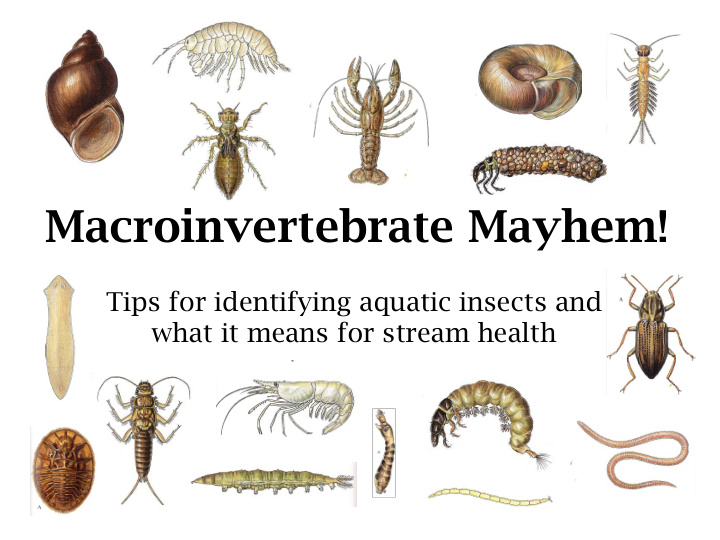



Macroinvertebrate Mayhem! Tips for identifying aquatic insects and what it means for stream health
WHY BUGS? Benthic Macroinvertebrates are good indicators of water quality because: • They live in the same portion of the stream most of their lives • Certain macroinvertebrates are more sensitive to pollution than others • These particular invertebrates are sampled because they can be seen with the naked eye
POLLUTION INTOLERANT: extremely sensitive to pollution
STONEFLY • Found in cool, clean streams with high levels of dissolved oxygen • Two long antennae • Two hair-like tails • Wing pads present, often very visible • Six segmented legs on middle section of body
MAYFLY • Live buried in soft stream beds • Three long hair-like tails • Plate-like or feathery gills along the side of the abdomen • Six segmented legs on middle section of body
COMPARISON STONEFLY MAYFLY
CADDISFLY • Make houses of rocks, sand, leaves, or twigs, or may make no case • Very small or no antennae • Six segmented legs on upper-middle section of body • Two small, thick extensions at each end of the body, and each has a hook at the end **May be out of the case when found
GILLED SNAILS • Shell opening has operculum (plate like door) • Having gills requires good water quality ( g ills= g ood) • Shell opens to the right when the tip of the shell is pointing up and the opening is facing you **It is important to make sure that the snail is in its shell before counting it
WATER PENNY • Flattened bodies that are oval, almost circular • Easy to identify, as name gives a good description of their appearance
DOBSONFLY • AKA, hellgrammite • Head is large with robust, toothed jaws that project forward • Lateral filaments along body • Short, fleshy, prolegs with hooks at end of body
RIFFLE BEETLE • Both adult and larvae are aquatic • Adults: hard bodied, cylindrical, usually dark brown or red- brown with various metallic tints • Larvae: elongate, cylindrical, usually dark brown or red- brown with six legs
WATERSNIPE FLY • Head small, often hidden from view • 8 pairs of fleshy prolegs • Posterior with 2 pointed, feathery protrusions longer than prolegs
POLLUTION SENSITIVE: somewhat sensitive to pollution
SCUD • AKA, side swimmer: swim rapidly on their sides • Body is flattened from side to side • Are usually found where there are plants in the water • Seven pairs of segmented legs • Color: creamy, translucent, light gray, or brown • Hard, plate-like shell
SOWBUG • Seven pairs of legs • Dark brown or gray in color • Two pairs of antennae, one pair much longer than the other • Distally flattened • In large numbers indicates organic enrichment
COMPARISON SCUD SOWBUG
CRANE FLY • No legs, worm-like body • Head small, often hidden from view • Fleshy protrusions at posterior end • Color: translucent, white, brown
NET SPINNING CADDISFLY • Have 3 hardened, darker plates on each thorax segment • Branched filamentous gills on bottom of abdomen • Often curled in tight ‘C’ shape
COMPARISON CASE BUILDING CADDISFLY NET SPINNING CADDISFLY
DRAGONFLY • Large eyes • Large scoop-like lower lip • Wide oval or round abdomen • Six long segmented legs on upper middle section of body
DAMSELFLY • Large eyes • Six long spindly legs on upper middle section of body • Narrow body with three oar-shaped tails (gills) that look like fans
CLAMS & MUSSELS • Hard shell • Shell may feel smooth or rough • If alive, two pieces of the shell will be closed together (bivalve) **ensure that shell pieces are closed for clam or mussel to be counted
POLLUTION TOLERANT: not very sensitive to pollution
AQUATIC WORM • May be red, tan, black or brown • Can look like an earthworm or be much narrower and thread- like • When found in large numbers indicates an organically polluted stream
LUNGED SNAIL • Shell is spiral, coiled, or dome shaped • Shell opens to the left when the tip of the shell is pointing up and the opening facing you ( l eft = l unged) • Can get oxygen from air trapped in their shell so they are less dependent on water quality **It is important to make sure that the snail is in its shell before counting it
COMPARISON GILLED SNAIL LUNGED SNAIL
MIDGE FLY • Have narrow, elongate bodies that are snake- like in appearance • Both ends similar width • Color: creamy white, red • Lacks hairs except at last segment of abdomen
BLACK FLY • Posterior 1/3 of body is enlarged = bowling pin shape • b owling pin = b lack fly • Often stuck to substrate by rear end • Clumps of hair on top of the head
COMPARISON MIDGE FLY BLACK FLY
LEECH • Worm-like segmented body • Body is somewhat flattened • Suckers on the underside at both ends • Are mainly scavengers that feed on other invertebrates
FLATWORM • Body is soft, elongate, flattened from top to bottom • No segments • Triangular, arrow-like shaped head • Two eyespots on top of the head • Color: dark gray, brown, or black
QUESTIONS?
Recommend
More recommend